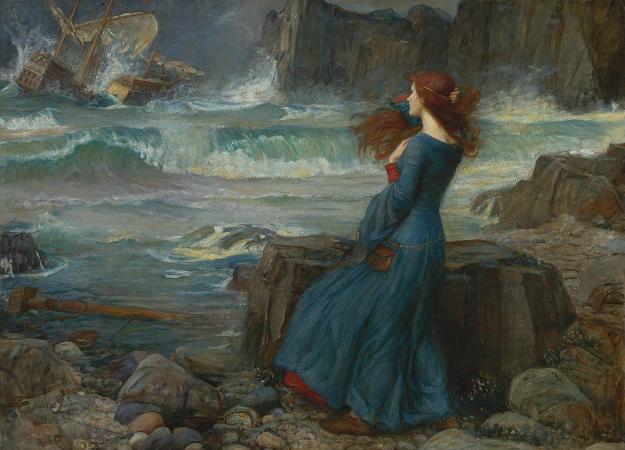Magic Circle (1886). Oil on canvas. 183 x 127. The Magic Circle is an oil painting in the Pre-Raphaelite style, created in 1886 by John William Waterhouse. The painting depicts a witch or sorceress drawing a fiery magic circle on the earth to create a ritual space. The Magic Circle was shown at the Royal Academy in 1886, and, after Consulting the Oracle and St. Eulalia, was Waterhouse's third exhibit with a supernatural theme in as many years. The painting was well received at its exhibition, and was purchased for E650 the same year by the Tate Gallery, through the Chantrey Bequest. The painting was extremely successful with the critics and public alike. Two smaller studies or complementary works of The Magic Circle were painted as well as a sepia pen and ink in 1880-1881. The Magic Circle was recently on display at the National Gallery of Australia as part of the Love and Desire exhibition. In a style typical of Waterhouse, the main character is a lone, female figure, placed centrally on the canvas. The surrounding landscape is hazy, as though it is not quite real, and the background figures are only discernible on close inspection, deliberately ensuring the witch is the only image of importance. Waterhouse paid careful attention to the angles employed in this work, balancing the circle the figure is drawing around herself by the use of a triangle-her straight arm, extended by the straight stick, held out at 25 degrees to her erect body. The witch's power is emphasised by the determined face, by her exclusion of the ravens and frog-popular symbols representing magic-and by her command over the smoke pillar. Instead of billowing outwards or being affected by the wind, it remains in a straight line. A live snake ouroboros loops around the woman's neck. The Magic Circle is similar in composition to Waterhouse's later picture, Miranda, also a woman associated with magic. The witch wears a similar dress to Miranda and her face can also only be seen in profile. Unlike Frederick Sandys' portrayals of sorceresses, such as his Medea or Morgan le Fay, Waterhouse chose to make his witch's face intent and intriguing, as opposed to malevolent. Miracles, magic and the power of prophecy are common themes in Waterhouse's art. More specifically, the notion of woman as enchantress is one that recurs in images such as Circe Offering the Cup to Ulysses and Hylas and the Nymphs. His oeuvre also includes a number of Middle Eastern subjects, in which he drew on the work of contemporary artists such as J. F. Lewis and Lawrence Alma-Tadema, rather than on actual experience. This is one of Waterhouse's earlier works, and reflects his fascination with the exotic. The woman in this picture appears to be a witch or priestess, endowed with magic powers, possibly the power of prophecy. Her dress and general appearance is highly eclectic, and is derived from several sources: she has the swarthy complexion of a woman of middle-eastern origin; her hairstyle is like that of an early Anglo-Saxon; her dress is decorated with Persian or Greek warriors. In her left hand she holds a crescent-shaped sickle, linking her with the moon and Hecate. With the wand in her right hand she draws a protective magic circle round her. Outside the circle the landscape is bare and barren; a group of rooks or ravens and a frog-all symbols of evil and associated with witchcraft-are excluded. But within its confines are flowers and the woman herself, objects of beauty. The meaning of the picture is unclear, but its mystery and exoticism struck a chord with contemporary observers. When the picture was exhibited at the Royal Academy in 1886 the critic for the Magazine of Art wrote Mr Waterhouse, in The Magic Circle, is still at his best-original in conception and pictorial in his results, quoted in Hobson, p. 37 An article in the Pre-Raphaelite Society journal, The Review, has hypothesised that Waterhouse may have painted an image of his own face into The Magic Circle and that the image is only viewable at a specific required distance from the painting. The article also suggests that it may have been possible to achieve that distance by viewing the painting through reversed binoculars or opera glasses. An accompanying documentary presents the visual argument. Harry Furniss created a number of parodies of The Magic Circle, including one in Punch showing actress Sarah Bernhardt tending a cauldron and another in an exhibition The Magic Circle, or There's Nothing like a Lather by Soap-and-Waterhouse. The Magic Circle was part of the Harry Potter: A History of Magic exhibition at the British Library in 2017. A reproduction of The Magic Circle is one of the paintings with an occult theme featuring in the set dressing of the TV series, The Chilling Adventures of Sabrina.
more...



